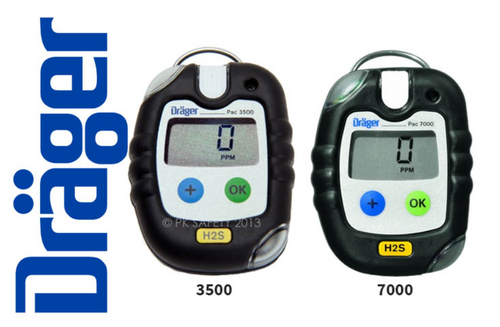Draeger Pac 3500 and Pac 7000 Monitors Really Are Different
Draeger has created some of the most widely used and accurate industrial gas detection devices in history. But many of the single-gas units look exactly alike. What are the differences and why are they trying to confuse us?
We've all heard it's what's on the inside that counts. That is especially true for the Draeger Pac 3500 and Pac 7000 single gas monitors. The housings are exactly the same, and at a glance you'd be hard pressed to tell the difference. But these two monitors vary in some important ways.
The single most significant difference between the two devices (besides the price) is life span. The Pac 3500 is a fixed-life device with a 2-year operational time limit. The Pac 7000 is what's called in the industry a "lifetime" monitor, meaning both battery and sensor can be replaced over and over.
The reasons a company would choose one over the other is as varied as the companies themselves. Some like the fact they can use the monitor for years and only need to consider replacing the components. Others prefer to draegerknow when their fixed cost expenditures will rear their heads; then there are the job sites that are just plain harder on their devices, and it makes more sense for them to buy a new round of detectors every two years.
Another big difference between these Draeger gas detectors are the sensors available for each. The Pac 3500 monitor offers only carbon monoxide, hydrogen sulfide, or oxygen. By contrast, the Pac 7000 offers a far wider selection. The 7000 series covers all major industry gases including hydrogen cyanide, phosphine, carbon dioxide, sulfur dioxide, nitrogen dioxide, chlorine, ammonia, OV, nitric oxide, as well as the sensor for low concentration of hydrogen sulfide.
Calibration schedules are another point of departure for these gas detectors. While the 3500 only needs bump testing before use, the Pac 7000 units, especially the ones measuring exotic gases, need to be calibrated on a regular schedule. For more information on how often to calibrate your monitor, click here.
Both of these devices are easy to use and ideal for industrial personal monitoring applications. They each provide quick, reliable detection of hazardous gas, and display that information constantly on a large, easy-to-read screen. While there are differences between the devices, Draeger quality is clearly evident in both.
Recent Posts
-
Promoting Safety: National Work Zone Awareness Week is April 15-19, 2024
Each year, the National Work Zone Awareness Week (NWZAW) places the spotlight on the importance o …Apr 11th 2024 -
Understanding 4 Gas Monitors: How They Work & Why They Are Important
In today’s increasingly dynamic industrial landscape, 4 gas monitors have emerged as critical com …Apr 8th 2024 -
April Showers Require Workers to Wear Hi-Vis Safety Rain Gear
While April showers bring May flowers, they also bring challenges, particularly for those working …Apr 1st 2024





